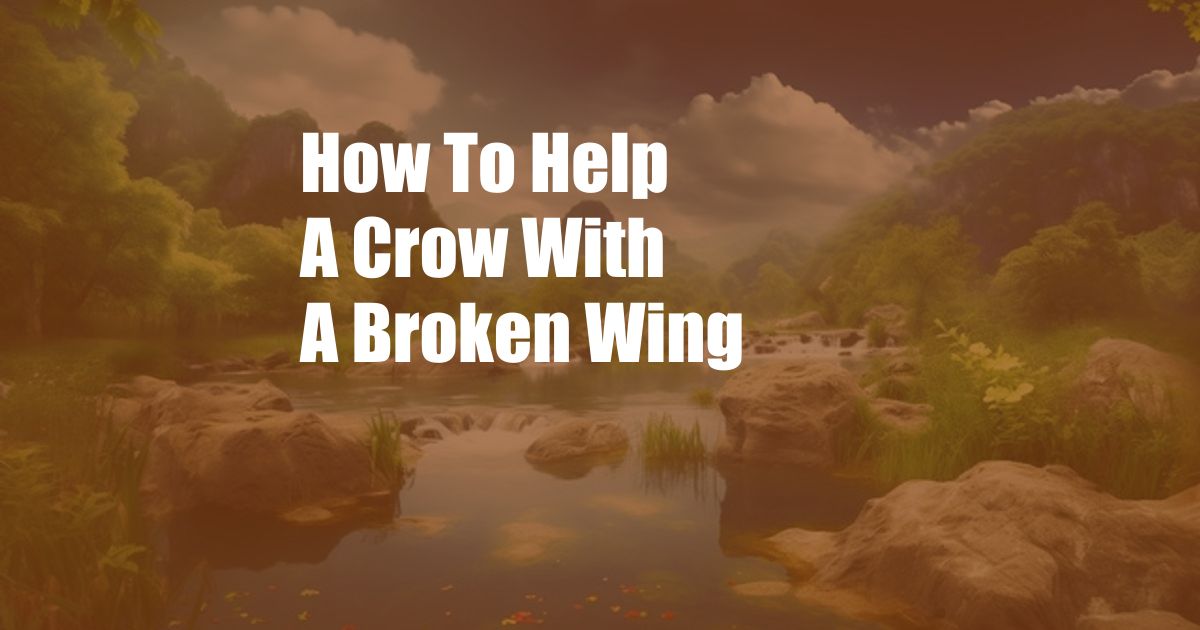
Helping a Crow with a Broken Wing: A Guide to Rehabilitation and Care
In a quiet woodland, amidst the rustling leaves and melodious bird songs, I stumbled upon a sight that tugged at my heartstrings. A majestic crow, its sleek black plumage ruffled and its flight curtailed, lay injured on the forest floor. Its left wing hung limply by its side, a telltale sign of a broken bone.
Moved by compassion, I knew I had to help. As I cautiously approached the injured bird, it regarded me with a mixture of fear and vulnerability. With gentle hands, I scooped it up, cradling its fragile body close to my own.
Assessing the Injury
The first step in helping a crow with a broken wing is to assess the severity of the injury. Examine the wing carefully, looking for any obvious fractures, dislocations, or open wounds. If the bone is protruding through the skin, it is essential to seek professional veterinary assistance immediately.
If the fracture is closed, you can attempt to stabilize the wing using a splint or bandage. For a simple fracture, a popsicle stick or thin piece of cardboard can be taped to the underside of the wing, extending from the shoulder to the tip of the feathers. If the fracture is more severe, it may require a more elaborate splint made from plaster or fiberglass.
Providing Care
Once the wing is stabilized, you need to provide a safe and comfortable environment for the crow to recover. Place it in a quiet, dimly lit room with plenty of fresh air. Ensure that the temperature is warm enough, as crows are susceptible to hypothermia. Line the bottom of the cage with soft towels or blankets for cushioning.
Crows are omnivores, so their diet should consist of a variety of foods. Offer a mixture of dry dog or cat food, hard-boiled eggs, fruits, and vegetables. Make sure to provide fresh water daily. If the crow is unable to eat on its own, you may need to hand-feed it using a syringe or dropper.
Monitoring and Rehabilitation
It is important to monitor the crow’s condition closely throughout the recovery process. Check the splint or bandage regularly to ensure that it is not causing any discomfort or restriction. Observe the crow’s appetite, activity level, and overall well-being. If you notice any signs of infection or distress, seek veterinary attention without delay.
As the crow’s wing heals, it will gradually start to move it more frequently. Encourage this movement by offering treats and toys that require the bird to use its injured wing. With proper care and rehabilitation, most crows can regain full function of their injured wing within a few weeks.
Expert Advice
- Handle the crow with care: Crows are wild animals and can be easily stressed or injured if handled improperly.
- Stabilize the wing properly: An improperly placed splint or bandage can cause further damage to the wing.
- Provide a quiet and safe environment: A stress-free environment is conducive to healing.
- Offer a healthy diet: A nutritious diet will provide the crow with the nutrients it needs to recover.
- Monitor the crow’s condition closely: Early detection of any complications is crucial for successful rehabilitation.
If you are unsure about any aspect of crow care or rehabilitation, it is always advisable to consult with a veterinarian or wildlife rehabilitator for guidance.
FAQs
Q: What should I do if I find a dead crow?
A: If you find a dead crow, it is important to contact your local wildlife agency or veterinarian for disposal.
Q: Can I keep a crow as a pet?
A: In most areas, it is illegal to keep a crow as a pet without a special permit. Crows are wild animals and should be allowed to live in their natural habitat.
Q: What should I do if I see a crow with an injured wing?
A: If you see a crow with an injured wing, you can attempt to stabilize the wing using a splint or bandage as described in this article. It is important to seek veterinary care if the fracture is severe or if the crow is in distress.
Conclusion
Helping a crow with a broken wing is a rewarding experience that can make a significant difference in the bird’s life. By following the steps outlined in this article, you can provide the crow with the care and support it needs to recover and return to its natural habitat.
If you have any further questions about crow rehabilitation or have a personal story to share, please leave a comment below. Together, we can create a more informed and compassionate world for these magnificent birds.